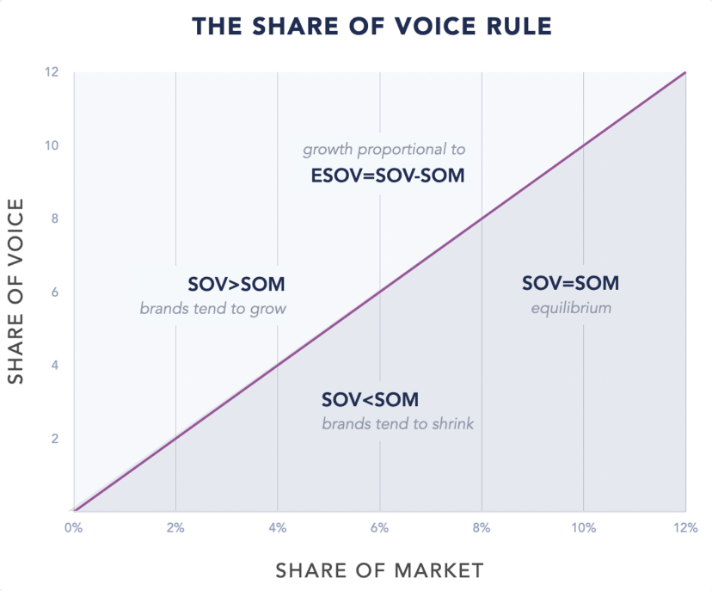It is natural for any business to focused on working hard to hit its current sales and revenue numbers. But when looking at the value of the business it is the expectation of future revenues that are a better predictor of its long-term success than how well it is doing in the current moment.
So, the question is, how do you reach into the future and give yourself the best opportunity of driving long term sales growth.
For more information on in-market and out-of-market demand generation please look at blog on out-of-market demand generation. The answer is to reach out using brand awareness activities out of market demand generation.
Brand marketers use Share of Voice as a long-term measure of a company’s marketing success.
Share of Voice (SOV) is a measure of how well your marketing messages engage with your target audience compared to how well your competitors engage with them. How visible is your brand compared to other brands in the market.
Share of voice is calculated as follows:
Brand’s market visibility / total visibility
Share of Voice a very strong (almost straight line) correlation with that company’s market share.
The rule of thumb here is that if your business has a 10% SOV then you expect it to have a 10% share of market (SOM).
If your SOV is consistently greater than your actual market share (otherwise known an extra share of voice (eSOV) then you should see your sales increase over time. This is conversely true, if your share of voice is lower than your market share you can expect your market share to fall.
eSOV = SOV – SOM
It has been calculated that for every 10% of eSOV you can expect to increase your market share by 0.5%. So, if your SOV is 20% and your current share of market is 10% you can expect to see your market share rise to 10.5%.
What is also shows is that increasing your market share takes time and resource. So if you keep your SOV above your SOM your market share will rise.
In the digital world, smaller as well as larger businesses can start to measure their SOV.

When the idea of share of voice was originally conceived, traditional offline advertising budgets were used as an analogue for the level of visibility for a brand. Realistically, this kind of measure was only available to largest brands.
Currently, we have digital marketing we have data sources which allows us to measure several touchpoints. This is especially helpful for smaller businesses where it is not easy to estimate the marketing budgets of competitors.
Share of voice can be measured in several ways: here are 4 main ways below. However, before you start measuring you need to identify a set of competitors (around 5 or so) that are realistic competitors for your key target markets.
If you are running Google Ads you can get an idea of your share of voice here by looking at impression share. In your Google Ads campaign data:
There are various tools for calculating share of voice for social media accounts. Generally, they are subscription services.
Another way is to look at:
I have added a weighting to each of the engagement types as they are not created equal. Applause such as “likes” are easy to do and have lower value. Shares require more trust of your brand and effort but convey far more benefit because they extend your reach. All posts that go viral have high rates of sharing.
Generally, getting an idea of your SEO share of voice will need access to an SEO tool such as Semrush, Moz, Ahrefs etc.
These tools will offer a competitive analysis option which will help you to get a read on several useful metrics:
Share of voice is about communicating with all your potential customers not just the tiny fraction that is currently in market.
Many small businesses spend their advertising budget on the small proportion that are in-market instead of the much larger group that are potential customers. With digital advertising and analytics, even small businesses can use brand advertising to raise their profile with those customers and start to measure meaningful results.
I am not recommending that businesses shouldn’t continue to find in-market customers using advertising but that this will should be balanced by a longer-term brand advertising.